Effective Teaching of Health and Physical Education
VerifiedAdded on 2022/03/28
|15
|3694
|38
AI Summary
The ability of educators to alter both their real and perceived capacities to support students in achieving academic success and enjoyment at school is referred to as effective teaching. It is crucial that teachers in the field of physical and health education carry out the curriculum because they are aware of the learning objectives outlined in the syllabus and how they relate to the national and international standards. According to Walker and Johnson, psychomotor, cognitive, and affective domains are used in lessons to address the learning objectives of the students. In order to analyse teacher education, coach education, and physical education, this study will evaluate the research on effective health and physical education.
Contribute Materials
Your contribution can guide someone’s learning journey. Share your
documents today.
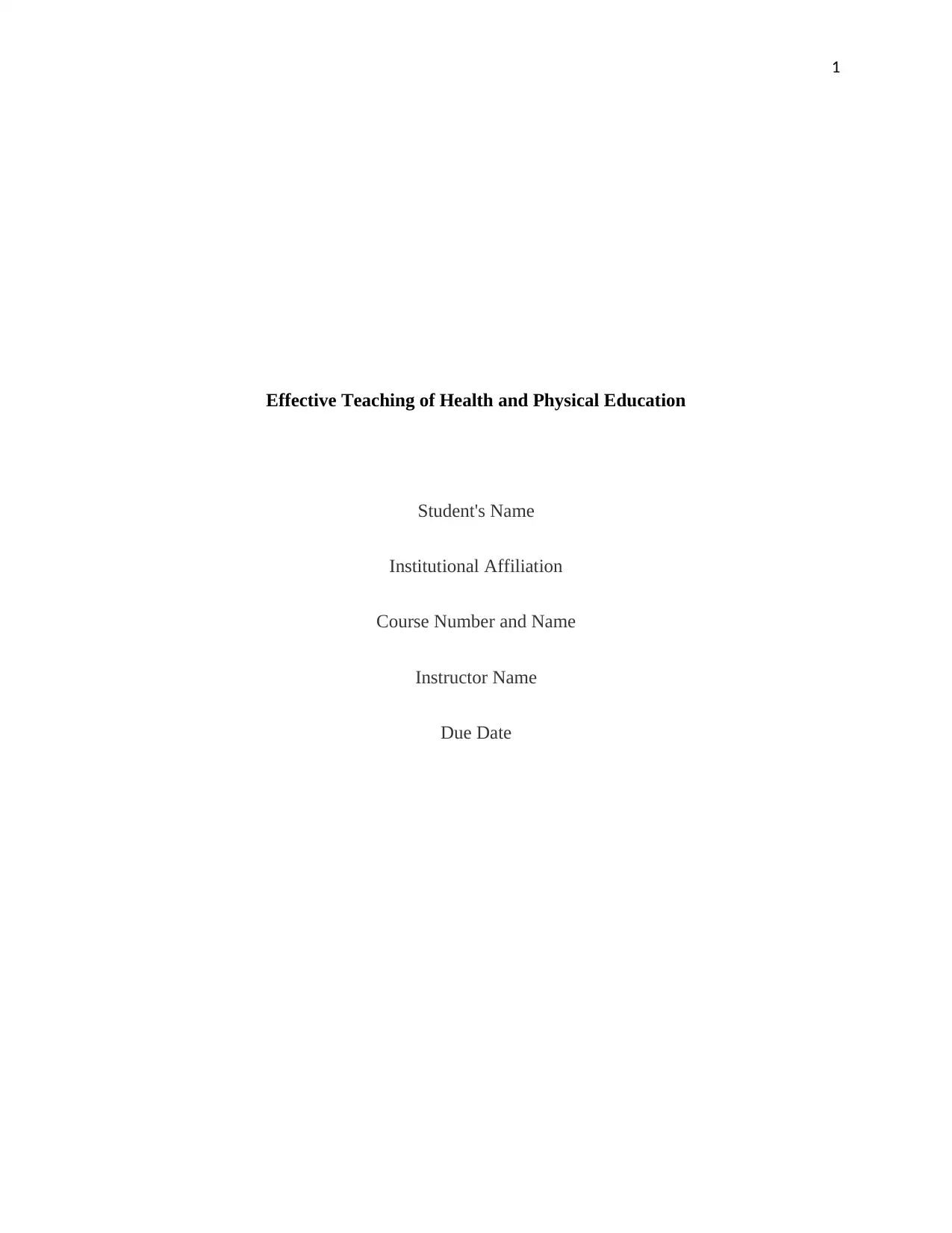
1
Effective Teaching of Health and Physical Education
Student's Name
Institutional Affiliation
Course Number and Name
Instructor Name
Due Date
Effective Teaching of Health and Physical Education
Student's Name
Institutional Affiliation
Course Number and Name
Instructor Name
Due Date
Secure Best Marks with AI Grader
Need help grading? Try our AI Grader for instant feedback on your assignments.
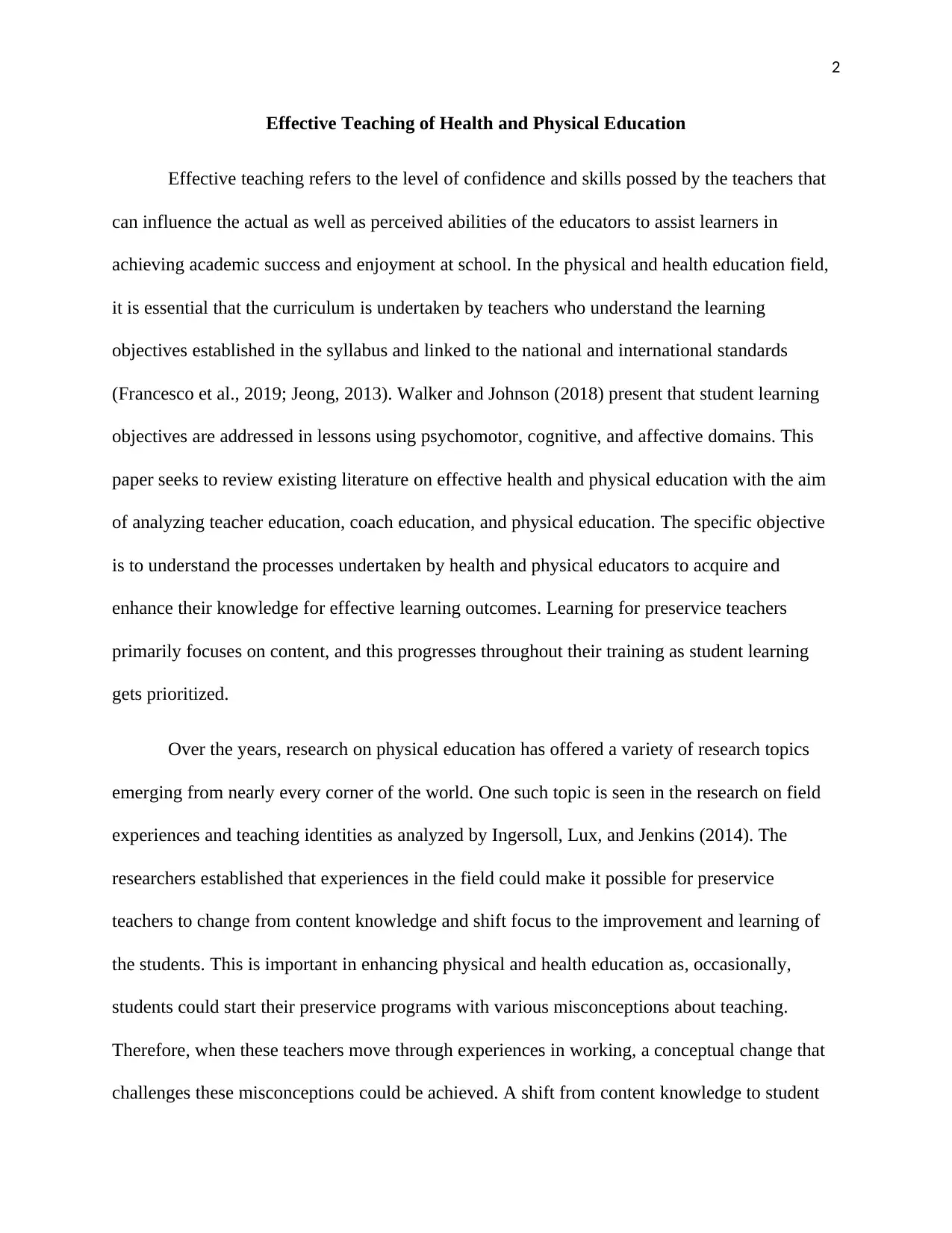
2
Effective Teaching of Health and Physical Education
Effective teaching refers to the level of confidence and skills possed by the teachers that
can influence the actual as well as perceived abilities of the educators to assist learners in
achieving academic success and enjoyment at school. In the physical and health education field,
it is essential that the curriculum is undertaken by teachers who understand the learning
objectives established in the syllabus and linked to the national and international standards
(Francesco et al., 2019; Jeong, 2013). Walker and Johnson (2018) present that student learning
objectives are addressed in lessons using psychomotor, cognitive, and affective domains. This
paper seeks to review existing literature on effective health and physical education with the aim
of analyzing teacher education, coach education, and physical education. The specific objective
is to understand the processes undertaken by health and physical educators to acquire and
enhance their knowledge for effective learning outcomes. Learning for preservice teachers
primarily focuses on content, and this progresses throughout their training as student learning
gets prioritized.
Over the years, research on physical education has offered a variety of research topics
emerging from nearly every corner of the world. One such topic is seen in the research on field
experiences and teaching identities as analyzed by Ingersoll, Lux, and Jenkins (2014). The
researchers established that experiences in the field could make it possible for preservice
teachers to change from content knowledge and shift focus to the improvement and learning of
the students. This is important in enhancing physical and health education as, occasionally,
students could start their preservice programs with various misconceptions about teaching.
Therefore, when these teachers move through experiences in working, a conceptual change that
challenges these misconceptions could be achieved. A shift from content knowledge to student
Effective Teaching of Health and Physical Education
Effective teaching refers to the level of confidence and skills possed by the teachers that
can influence the actual as well as perceived abilities of the educators to assist learners in
achieving academic success and enjoyment at school. In the physical and health education field,
it is essential that the curriculum is undertaken by teachers who understand the learning
objectives established in the syllabus and linked to the national and international standards
(Francesco et al., 2019; Jeong, 2013). Walker and Johnson (2018) present that student learning
objectives are addressed in lessons using psychomotor, cognitive, and affective domains. This
paper seeks to review existing literature on effective health and physical education with the aim
of analyzing teacher education, coach education, and physical education. The specific objective
is to understand the processes undertaken by health and physical educators to acquire and
enhance their knowledge for effective learning outcomes. Learning for preservice teachers
primarily focuses on content, and this progresses throughout their training as student learning
gets prioritized.
Over the years, research on physical education has offered a variety of research topics
emerging from nearly every corner of the world. One such topic is seen in the research on field
experiences and teaching identities as analyzed by Ingersoll, Lux, and Jenkins (2014). The
researchers established that experiences in the field could make it possible for preservice
teachers to change from content knowledge and shift focus to the improvement and learning of
the students. This is important in enhancing physical and health education as, occasionally,
students could start their preservice programs with various misconceptions about teaching.
Therefore, when these teachers move through experiences in working, a conceptual change that
challenges these misconceptions could be achieved. A shift from content knowledge to student
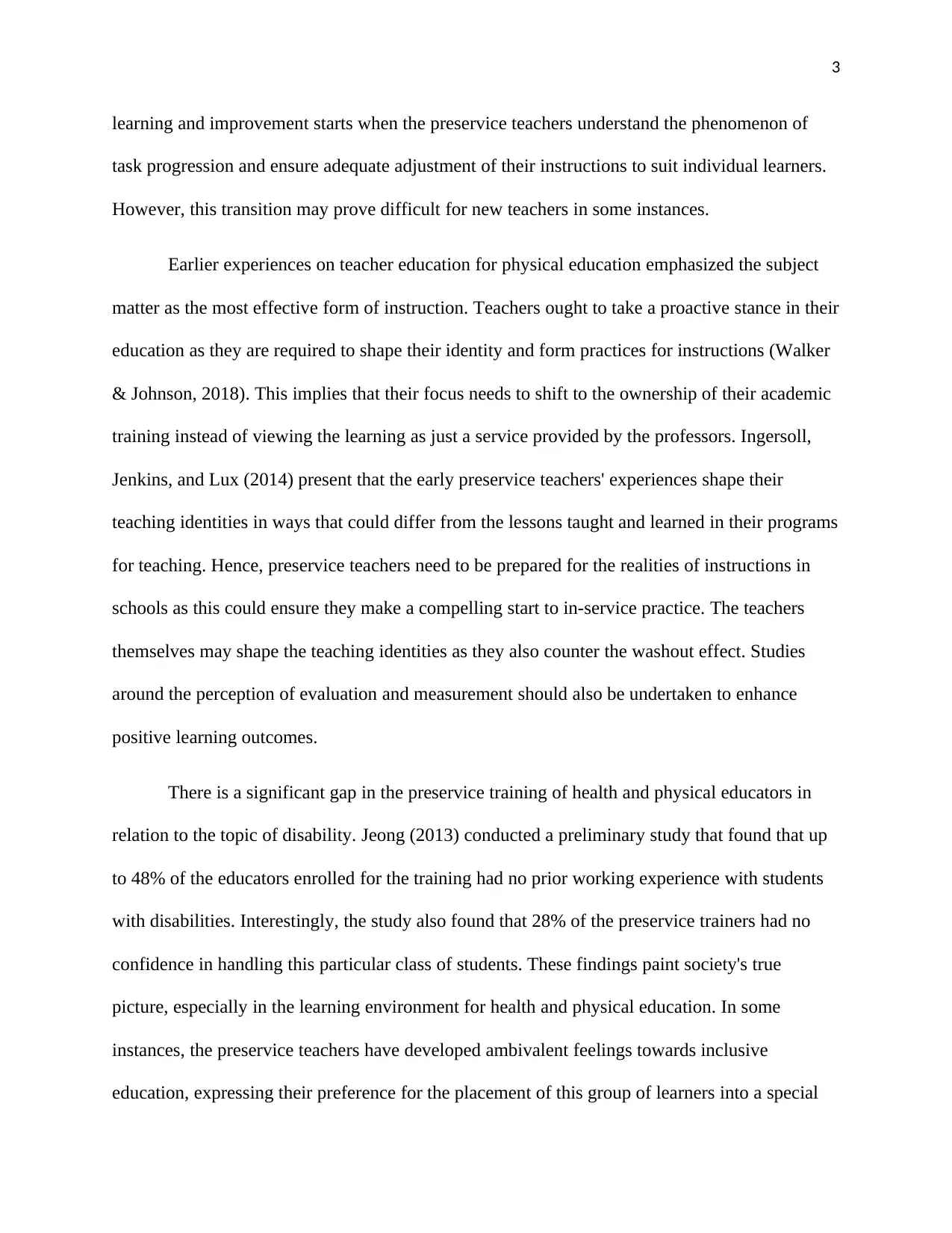
3
learning and improvement starts when the preservice teachers understand the phenomenon of
task progression and ensure adequate adjustment of their instructions to suit individual learners.
However, this transition may prove difficult for new teachers in some instances.
Earlier experiences on teacher education for physical education emphasized the subject
matter as the most effective form of instruction. Teachers ought to take a proactive stance in their
education as they are required to shape their identity and form practices for instructions (Walker
& Johnson, 2018). This implies that their focus needs to shift to the ownership of their academic
training instead of viewing the learning as just a service provided by the professors. Ingersoll,
Jenkins, and Lux (2014) present that the early preservice teachers' experiences shape their
teaching identities in ways that could differ from the lessons taught and learned in their programs
for teaching. Hence, preservice teachers need to be prepared for the realities of instructions in
schools as this could ensure they make a compelling start to in-service practice. The teachers
themselves may shape the teaching identities as they also counter the washout effect. Studies
around the perception of evaluation and measurement should also be undertaken to enhance
positive learning outcomes.
There is a significant gap in the preservice training of health and physical educators in
relation to the topic of disability. Jeong (2013) conducted a preliminary study that found that up
to 48% of the educators enrolled for the training had no prior working experience with students
with disabilities. Interestingly, the study also found that 28% of the preservice trainers had no
confidence in handling this particular class of students. These findings paint society's true
picture, especially in the learning environment for health and physical education. In some
instances, the preservice teachers have developed ambivalent feelings towards inclusive
education, expressing their preference for the placement of this group of learners into a special
learning and improvement starts when the preservice teachers understand the phenomenon of
task progression and ensure adequate adjustment of their instructions to suit individual learners.
However, this transition may prove difficult for new teachers in some instances.
Earlier experiences on teacher education for physical education emphasized the subject
matter as the most effective form of instruction. Teachers ought to take a proactive stance in their
education as they are required to shape their identity and form practices for instructions (Walker
& Johnson, 2018). This implies that their focus needs to shift to the ownership of their academic
training instead of viewing the learning as just a service provided by the professors. Ingersoll,
Jenkins, and Lux (2014) present that the early preservice teachers' experiences shape their
teaching identities in ways that could differ from the lessons taught and learned in their programs
for teaching. Hence, preservice teachers need to be prepared for the realities of instructions in
schools as this could ensure they make a compelling start to in-service practice. The teachers
themselves may shape the teaching identities as they also counter the washout effect. Studies
around the perception of evaluation and measurement should also be undertaken to enhance
positive learning outcomes.
There is a significant gap in the preservice training of health and physical educators in
relation to the topic of disability. Jeong (2013) conducted a preliminary study that found that up
to 48% of the educators enrolled for the training had no prior working experience with students
with disabilities. Interestingly, the study also found that 28% of the preservice trainers had no
confidence in handling this particular class of students. These findings paint society's true
picture, especially in the learning environment for health and physical education. In some
instances, the preservice teachers have developed ambivalent feelings towards inclusive
education, expressing their preference for the placement of this group of learners into a special
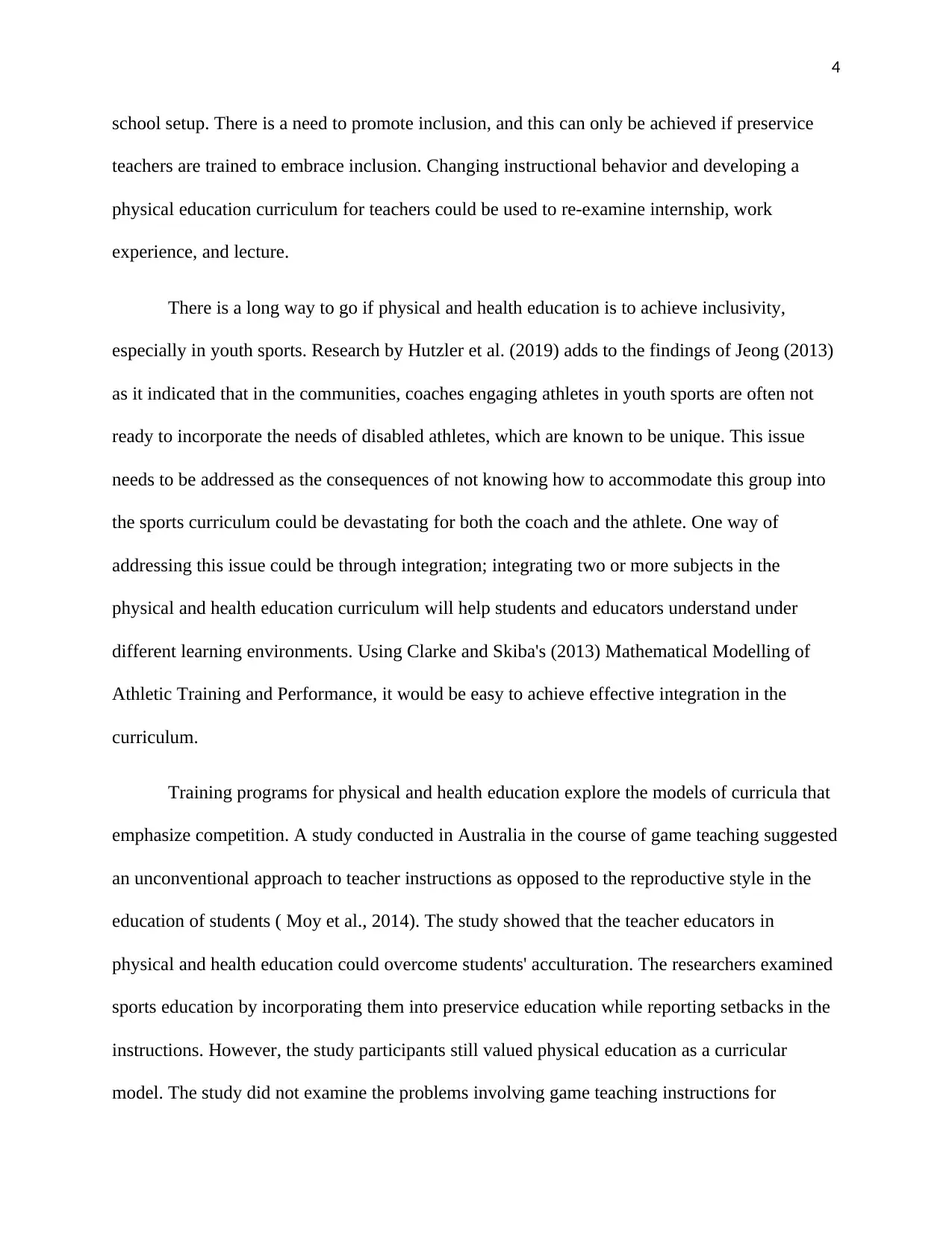
4
school setup. There is a need to promote inclusion, and this can only be achieved if preservice
teachers are trained to embrace inclusion. Changing instructional behavior and developing a
physical education curriculum for teachers could be used to re-examine internship, work
experience, and lecture.
There is a long way to go if physical and health education is to achieve inclusivity,
especially in youth sports. Research by Hutzler et al. (2019) adds to the findings of Jeong (2013)
as it indicated that in the communities, coaches engaging athletes in youth sports are often not
ready to incorporate the needs of disabled athletes, which are known to be unique. This issue
needs to be addressed as the consequences of not knowing how to accommodate this group into
the sports curriculum could be devastating for both the coach and the athlete. One way of
addressing this issue could be through integration; integrating two or more subjects in the
physical and health education curriculum will help students and educators understand under
different learning environments. Using Clarke and Skiba's (2013) Mathematical Modelling of
Athletic Training and Performance, it would be easy to achieve effective integration in the
curriculum.
Training programs for physical and health education explore the models of curricula that
emphasize competition. A study conducted in Australia in the course of game teaching suggested
an unconventional approach to teacher instructions as opposed to the reproductive style in the
education of students ( Moy et al., 2014). The study showed that the teacher educators in
physical and health education could overcome students' acculturation. The researchers examined
sports education by incorporating them into preservice education while reporting setbacks in the
instructions. However, the study participants still valued physical education as a curricular
model. The study did not examine the problems involving game teaching instructions for
school setup. There is a need to promote inclusion, and this can only be achieved if preservice
teachers are trained to embrace inclusion. Changing instructional behavior and developing a
physical education curriculum for teachers could be used to re-examine internship, work
experience, and lecture.
There is a long way to go if physical and health education is to achieve inclusivity,
especially in youth sports. Research by Hutzler et al. (2019) adds to the findings of Jeong (2013)
as it indicated that in the communities, coaches engaging athletes in youth sports are often not
ready to incorporate the needs of disabled athletes, which are known to be unique. This issue
needs to be addressed as the consequences of not knowing how to accommodate this group into
the sports curriculum could be devastating for both the coach and the athlete. One way of
addressing this issue could be through integration; integrating two or more subjects in the
physical and health education curriculum will help students and educators understand under
different learning environments. Using Clarke and Skiba's (2013) Mathematical Modelling of
Athletic Training and Performance, it would be easy to achieve effective integration in the
curriculum.
Training programs for physical and health education explore the models of curricula that
emphasize competition. A study conducted in Australia in the course of game teaching suggested
an unconventional approach to teacher instructions as opposed to the reproductive style in the
education of students ( Moy et al., 2014). The study showed that the teacher educators in
physical and health education could overcome students' acculturation. The researchers examined
sports education by incorporating them into preservice education while reporting setbacks in the
instructions. However, the study participants still valued physical education as a curricular
model. The study did not examine the problems involving game teaching instructions for
Secure Best Marks with AI Grader
Need help grading? Try our AI Grader for instant feedback on your assignments.
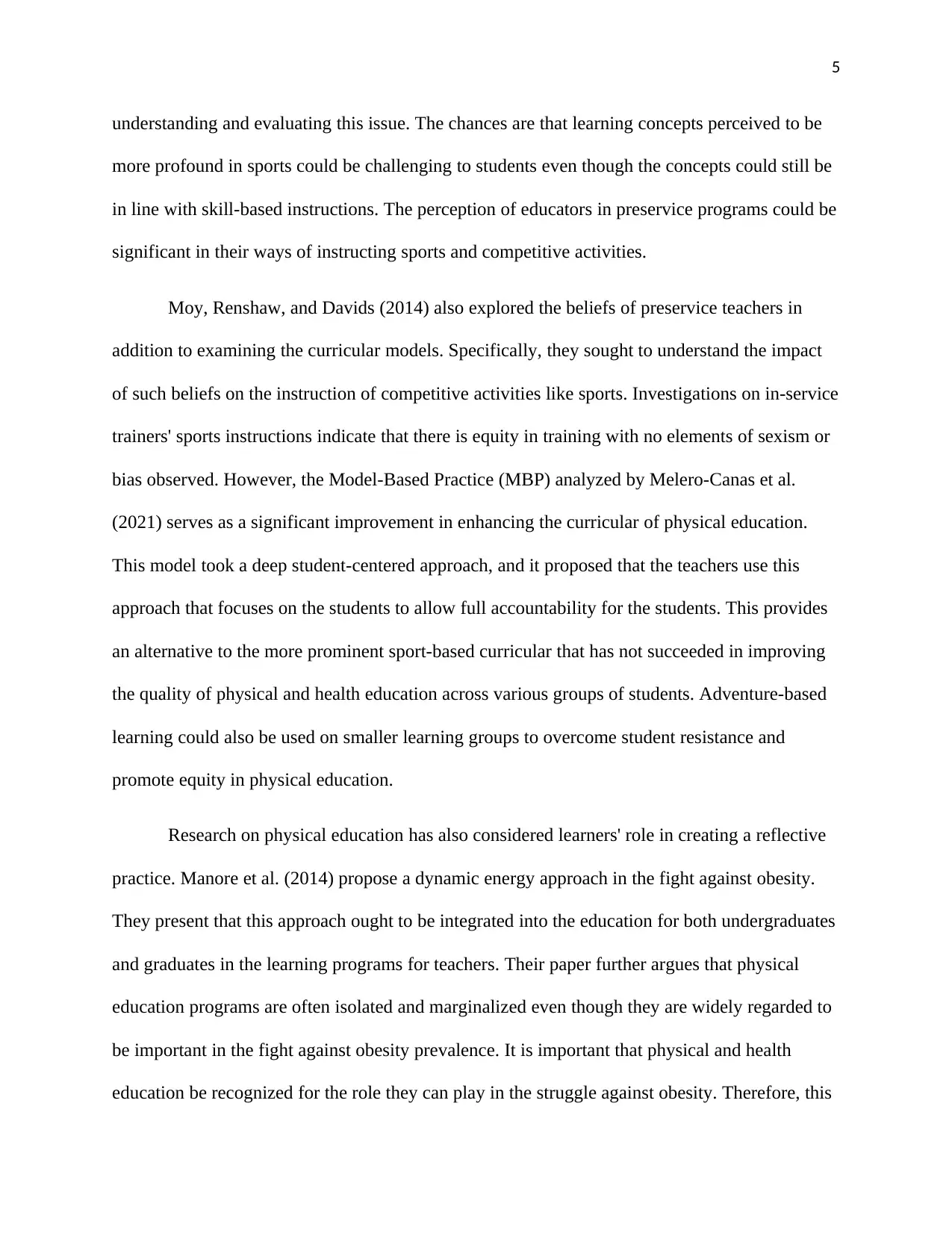
5
understanding and evaluating this issue. The chances are that learning concepts perceived to be
more profound in sports could be challenging to students even though the concepts could still be
in line with skill-based instructions. The perception of educators in preservice programs could be
significant in their ways of instructing sports and competitive activities.
Moy, Renshaw, and Davids (2014) also explored the beliefs of preservice teachers in
addition to examining the curricular models. Specifically, they sought to understand the impact
of such beliefs on the instruction of competitive activities like sports. Investigations on in-service
trainers' sports instructions indicate that there is equity in training with no elements of sexism or
bias observed. However, the Model-Based Practice (MBP) analyzed by Melero-Canas et al.
(2021) serves as a significant improvement in enhancing the curricular of physical education.
This model took a deep student-centered approach, and it proposed that the teachers use this
approach that focuses on the students to allow full accountability for the students. This provides
an alternative to the more prominent sport-based curricular that has not succeeded in improving
the quality of physical and health education across various groups of students. Adventure-based
learning could also be used on smaller learning groups to overcome student resistance and
promote equity in physical education.
Research on physical education has also considered learners' role in creating a reflective
practice. Manore et al. (2014) propose a dynamic energy approach in the fight against obesity.
They present that this approach ought to be integrated into the education for both undergraduates
and graduates in the learning programs for teachers. Their paper further argues that physical
education programs are often isolated and marginalized even though they are widely regarded to
be important in the fight against obesity prevalence. It is important that physical and health
education be recognized for the role they can play in the struggle against obesity. Therefore, this
understanding and evaluating this issue. The chances are that learning concepts perceived to be
more profound in sports could be challenging to students even though the concepts could still be
in line with skill-based instructions. The perception of educators in preservice programs could be
significant in their ways of instructing sports and competitive activities.
Moy, Renshaw, and Davids (2014) also explored the beliefs of preservice teachers in
addition to examining the curricular models. Specifically, they sought to understand the impact
of such beliefs on the instruction of competitive activities like sports. Investigations on in-service
trainers' sports instructions indicate that there is equity in training with no elements of sexism or
bias observed. However, the Model-Based Practice (MBP) analyzed by Melero-Canas et al.
(2021) serves as a significant improvement in enhancing the curricular of physical education.
This model took a deep student-centered approach, and it proposed that the teachers use this
approach that focuses on the students to allow full accountability for the students. This provides
an alternative to the more prominent sport-based curricular that has not succeeded in improving
the quality of physical and health education across various groups of students. Adventure-based
learning could also be used on smaller learning groups to overcome student resistance and
promote equity in physical education.
Research on physical education has also considered learners' role in creating a reflective
practice. Manore et al. (2014) propose a dynamic energy approach in the fight against obesity.
They present that this approach ought to be integrated into the education for both undergraduates
and graduates in the learning programs for teachers. Their paper further argues that physical
education programs are often isolated and marginalized even though they are widely regarded to
be important in the fight against obesity prevalence. It is important that physical and health
education be recognized for the role they can play in the struggle against obesity. Therefore, this
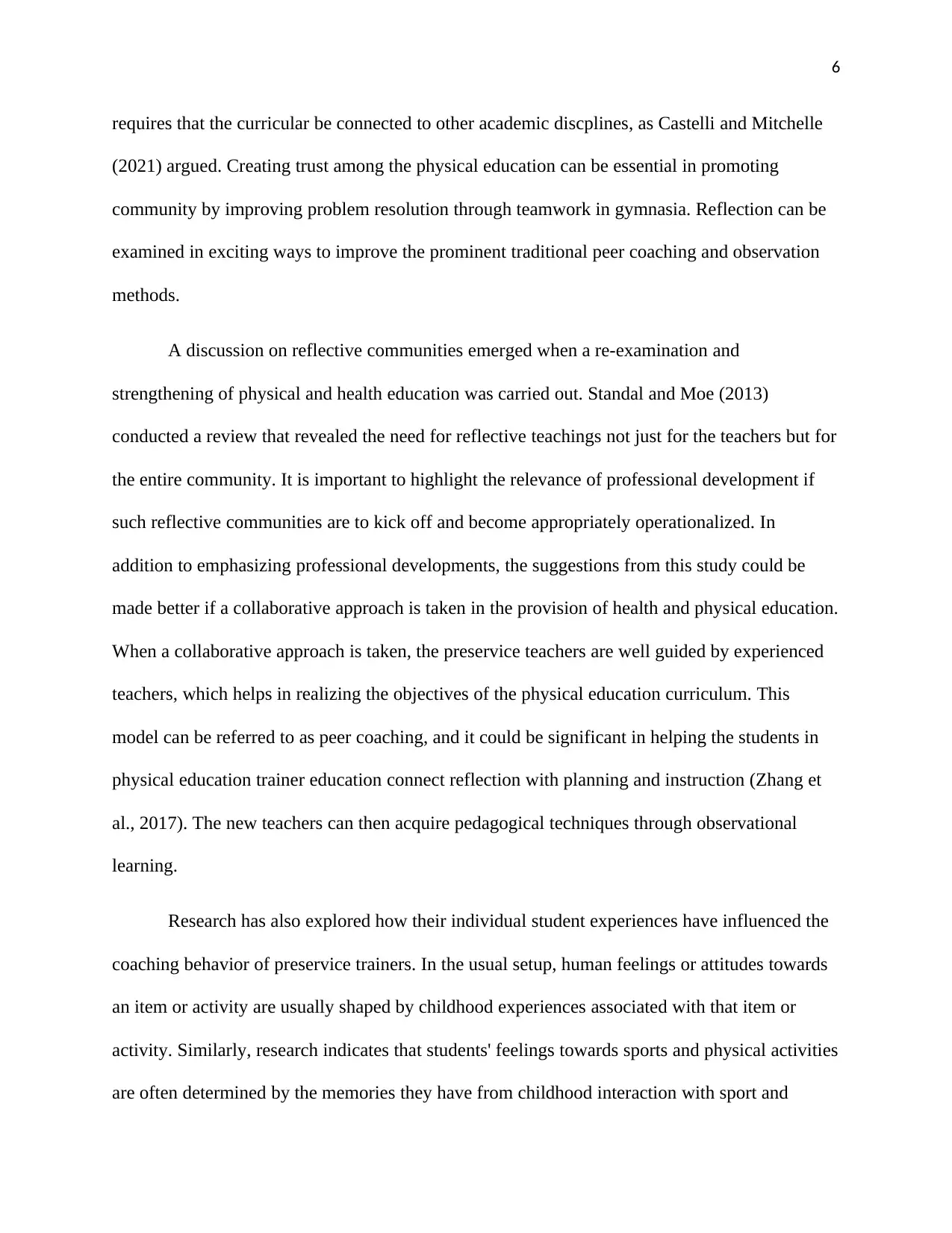
6
requires that the curricular be connected to other academic discplines, as Castelli and Mitchelle
(2021) argued. Creating trust among the physical education can be essential in promoting
community by improving problem resolution through teamwork in gymnasia. Reflection can be
examined in exciting ways to improve the prominent traditional peer coaching and observation
methods.
A discussion on reflective communities emerged when a re-examination and
strengthening of physical and health education was carried out. Standal and Moe (2013)
conducted a review that revealed the need for reflective teachings not just for the teachers but for
the entire community. It is important to highlight the relevance of professional development if
such reflective communities are to kick off and become appropriately operationalized. In
addition to emphasizing professional developments, the suggestions from this study could be
made better if a collaborative approach is taken in the provision of health and physical education.
When a collaborative approach is taken, the preservice teachers are well guided by experienced
teachers, which helps in realizing the objectives of the physical education curriculum. This
model can be referred to as peer coaching, and it could be significant in helping the students in
physical education trainer education connect reflection with planning and instruction (Zhang et
al., 2017). The new teachers can then acquire pedagogical techniques through observational
learning.
Research has also explored how their individual student experiences have influenced the
coaching behavior of preservice trainers. In the usual setup, human feelings or attitudes towards
an item or activity are usually shaped by childhood experiences associated with that item or
activity. Similarly, research indicates that students' feelings towards sports and physical activities
are often determined by the memories they have from childhood interaction with sport and
requires that the curricular be connected to other academic discplines, as Castelli and Mitchelle
(2021) argued. Creating trust among the physical education can be essential in promoting
community by improving problem resolution through teamwork in gymnasia. Reflection can be
examined in exciting ways to improve the prominent traditional peer coaching and observation
methods.
A discussion on reflective communities emerged when a re-examination and
strengthening of physical and health education was carried out. Standal and Moe (2013)
conducted a review that revealed the need for reflective teachings not just for the teachers but for
the entire community. It is important to highlight the relevance of professional development if
such reflective communities are to kick off and become appropriately operationalized. In
addition to emphasizing professional developments, the suggestions from this study could be
made better if a collaborative approach is taken in the provision of health and physical education.
When a collaborative approach is taken, the preservice teachers are well guided by experienced
teachers, which helps in realizing the objectives of the physical education curriculum. This
model can be referred to as peer coaching, and it could be significant in helping the students in
physical education trainer education connect reflection with planning and instruction (Zhang et
al., 2017). The new teachers can then acquire pedagogical techniques through observational
learning.
Research has also explored how their individual student experiences have influenced the
coaching behavior of preservice trainers. In the usual setup, human feelings or attitudes towards
an item or activity are usually shaped by childhood experiences associated with that item or
activity. Similarly, research indicates that students' feelings towards sports and physical activities
are often determined by the memories they have from childhood interaction with sport and
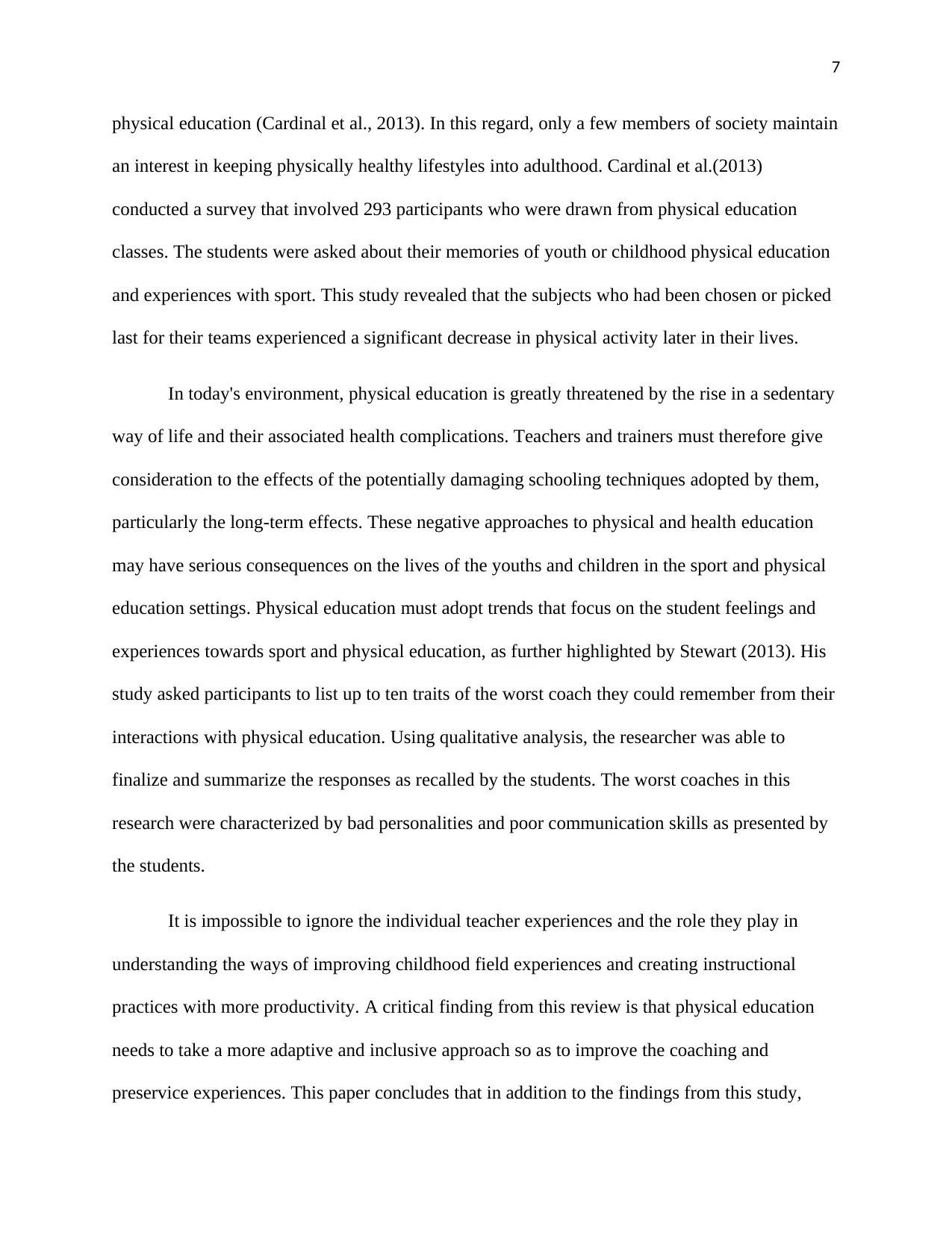
7
physical education (Cardinal et al., 2013). In this regard, only a few members of society maintain
an interest in keeping physically healthy lifestyles into adulthood. Cardinal et al.(2013)
conducted a survey that involved 293 participants who were drawn from physical education
classes. The students were asked about their memories of youth or childhood physical education
and experiences with sport. This study revealed that the subjects who had been chosen or picked
last for their teams experienced a significant decrease in physical activity later in their lives.
In today's environment, physical education is greatly threatened by the rise in a sedentary
way of life and their associated health complications. Teachers and trainers must therefore give
consideration to the effects of the potentially damaging schooling techniques adopted by them,
particularly the long-term effects. These negative approaches to physical and health education
may have serious consequences on the lives of the youths and children in the sport and physical
education settings. Physical education must adopt trends that focus on the student feelings and
experiences towards sport and physical education, as further highlighted by Stewart (2013). His
study asked participants to list up to ten traits of the worst coach they could remember from their
interactions with physical education. Using qualitative analysis, the researcher was able to
finalize and summarize the responses as recalled by the students. The worst coaches in this
research were characterized by bad personalities and poor communication skills as presented by
the students.
It is impossible to ignore the individual teacher experiences and the role they play in
understanding the ways of improving childhood field experiences and creating instructional
practices with more productivity. A critical finding from this review is that physical education
needs to take a more adaptive and inclusive approach so as to improve the coaching and
preservice experiences. This paper concludes that in addition to the findings from this study,
physical education (Cardinal et al., 2013). In this regard, only a few members of society maintain
an interest in keeping physically healthy lifestyles into adulthood. Cardinal et al.(2013)
conducted a survey that involved 293 participants who were drawn from physical education
classes. The students were asked about their memories of youth or childhood physical education
and experiences with sport. This study revealed that the subjects who had been chosen or picked
last for their teams experienced a significant decrease in physical activity later in their lives.
In today's environment, physical education is greatly threatened by the rise in a sedentary
way of life and their associated health complications. Teachers and trainers must therefore give
consideration to the effects of the potentially damaging schooling techniques adopted by them,
particularly the long-term effects. These negative approaches to physical and health education
may have serious consequences on the lives of the youths and children in the sport and physical
education settings. Physical education must adopt trends that focus on the student feelings and
experiences towards sport and physical education, as further highlighted by Stewart (2013). His
study asked participants to list up to ten traits of the worst coach they could remember from their
interactions with physical education. Using qualitative analysis, the researcher was able to
finalize and summarize the responses as recalled by the students. The worst coaches in this
research were characterized by bad personalities and poor communication skills as presented by
the students.
It is impossible to ignore the individual teacher experiences and the role they play in
understanding the ways of improving childhood field experiences and creating instructional
practices with more productivity. A critical finding from this review is that physical education
needs to take a more adaptive and inclusive approach so as to improve the coaching and
preservice experiences. This paper concludes that in addition to the findings from this study,
Paraphrase This Document
Need a fresh take? Get an instant paraphrase of this document with our AI Paraphraser
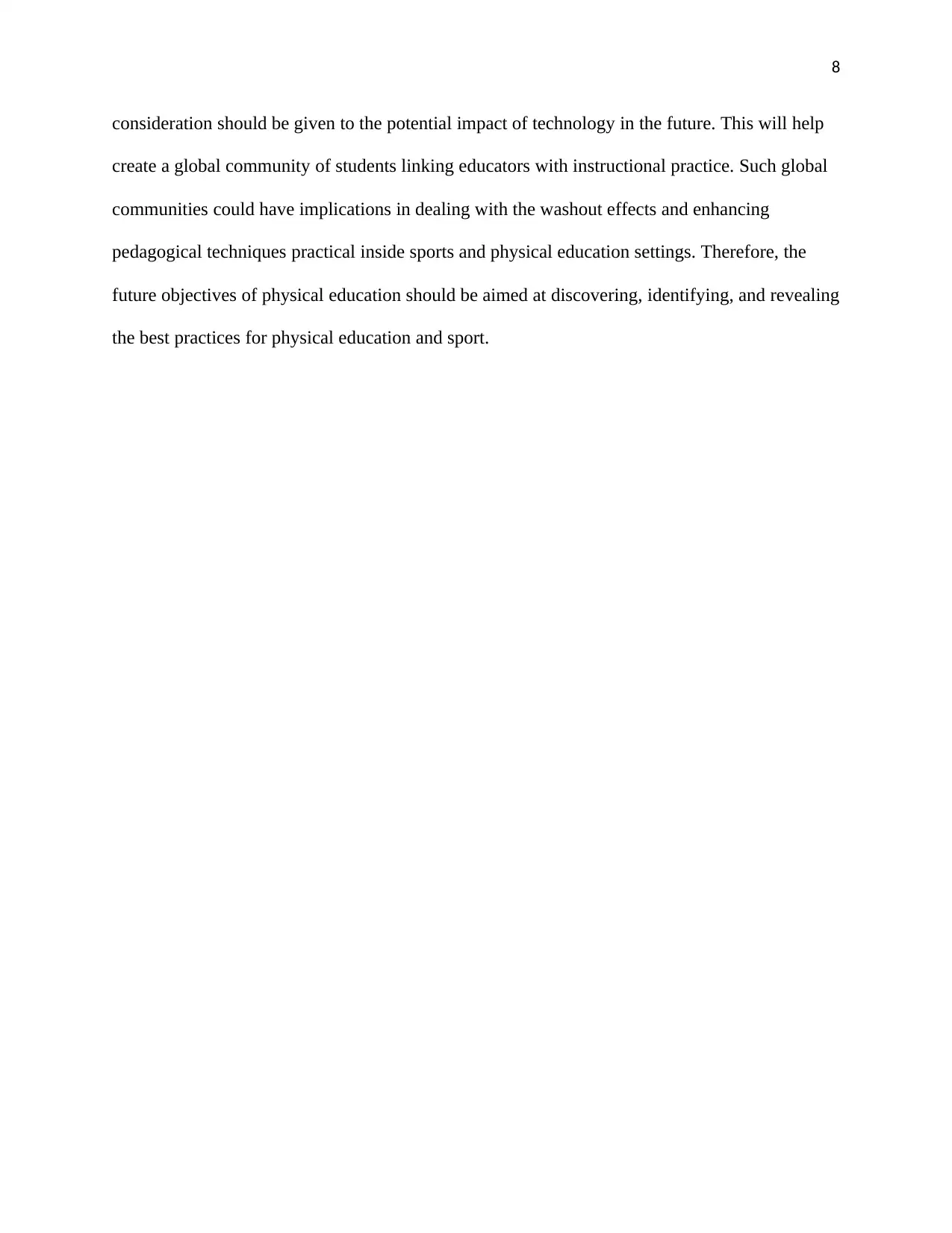
8
consideration should be given to the potential impact of technology in the future. This will help
create a global community of students linking educators with instructional practice. Such global
communities could have implications in dealing with the washout effects and enhancing
pedagogical techniques practical inside sports and physical education settings. Therefore, the
future objectives of physical education should be aimed at discovering, identifying, and revealing
the best practices for physical education and sport.
consideration should be given to the potential impact of technology in the future. This will help
create a global community of students linking educators with instructional practice. Such global
communities could have implications in dealing with the washout effects and enhancing
pedagogical techniques practical inside sports and physical education settings. Therefore, the
future objectives of physical education should be aimed at discovering, identifying, and revealing
the best practices for physical education and sport.
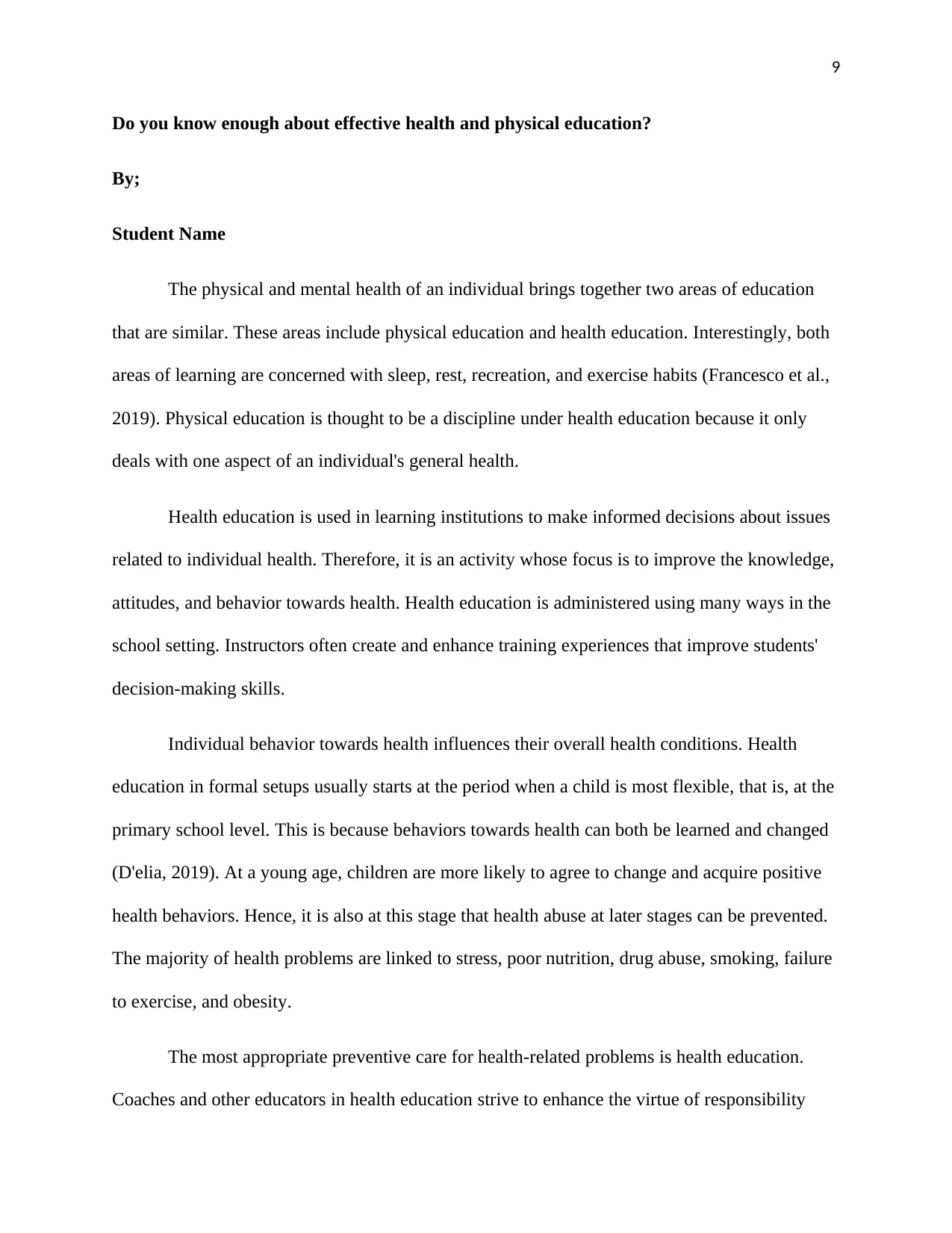
9
Do you know enough about effective health and physical education?
By;
Student Name
The physical and mental health of an individual brings together two areas of education
that are similar. These areas include physical education and health education. Interestingly, both
areas of learning are concerned with sleep, rest, recreation, and exercise habits (Francesco et al.,
2019). Physical education is thought to be a discipline under health education because it only
deals with one aspect of an individual's general health.
Health education is used in learning institutions to make informed decisions about issues
related to individual health. Therefore, it is an activity whose focus is to improve the knowledge,
attitudes, and behavior towards health. Health education is administered using many ways in the
school setting. Instructors often create and enhance training experiences that improve students'
decision-making skills.
Individual behavior towards health influences their overall health conditions. Health
education in formal setups usually starts at the period when a child is most flexible, that is, at the
primary school level. This is because behaviors towards health can both be learned and changed
(D'elia, 2019). At a young age, children are more likely to agree to change and acquire positive
health behaviors. Hence, it is also at this stage that health abuse at later stages can be prevented.
The majority of health problems are linked to stress, poor nutrition, drug abuse, smoking, failure
to exercise, and obesity.
The most appropriate preventive care for health-related problems is health education.
Coaches and other educators in health education strive to enhance the virtue of responsibility
Do you know enough about effective health and physical education?
By;
Student Name
The physical and mental health of an individual brings together two areas of education
that are similar. These areas include physical education and health education. Interestingly, both
areas of learning are concerned with sleep, rest, recreation, and exercise habits (Francesco et al.,
2019). Physical education is thought to be a discipline under health education because it only
deals with one aspect of an individual's general health.
Health education is used in learning institutions to make informed decisions about issues
related to individual health. Therefore, it is an activity whose focus is to improve the knowledge,
attitudes, and behavior towards health. Health education is administered using many ways in the
school setting. Instructors often create and enhance training experiences that improve students'
decision-making skills.
Individual behavior towards health influences their overall health conditions. Health
education in formal setups usually starts at the period when a child is most flexible, that is, at the
primary school level. This is because behaviors towards health can both be learned and changed
(D'elia, 2019). At a young age, children are more likely to agree to change and acquire positive
health behaviors. Hence, it is also at this stage that health abuse at later stages can be prevented.
The majority of health problems are linked to stress, poor nutrition, drug abuse, smoking, failure
to exercise, and obesity.
The most appropriate preventive care for health-related problems is health education.
Coaches and other educators in health education strive to enhance the virtue of responsibility
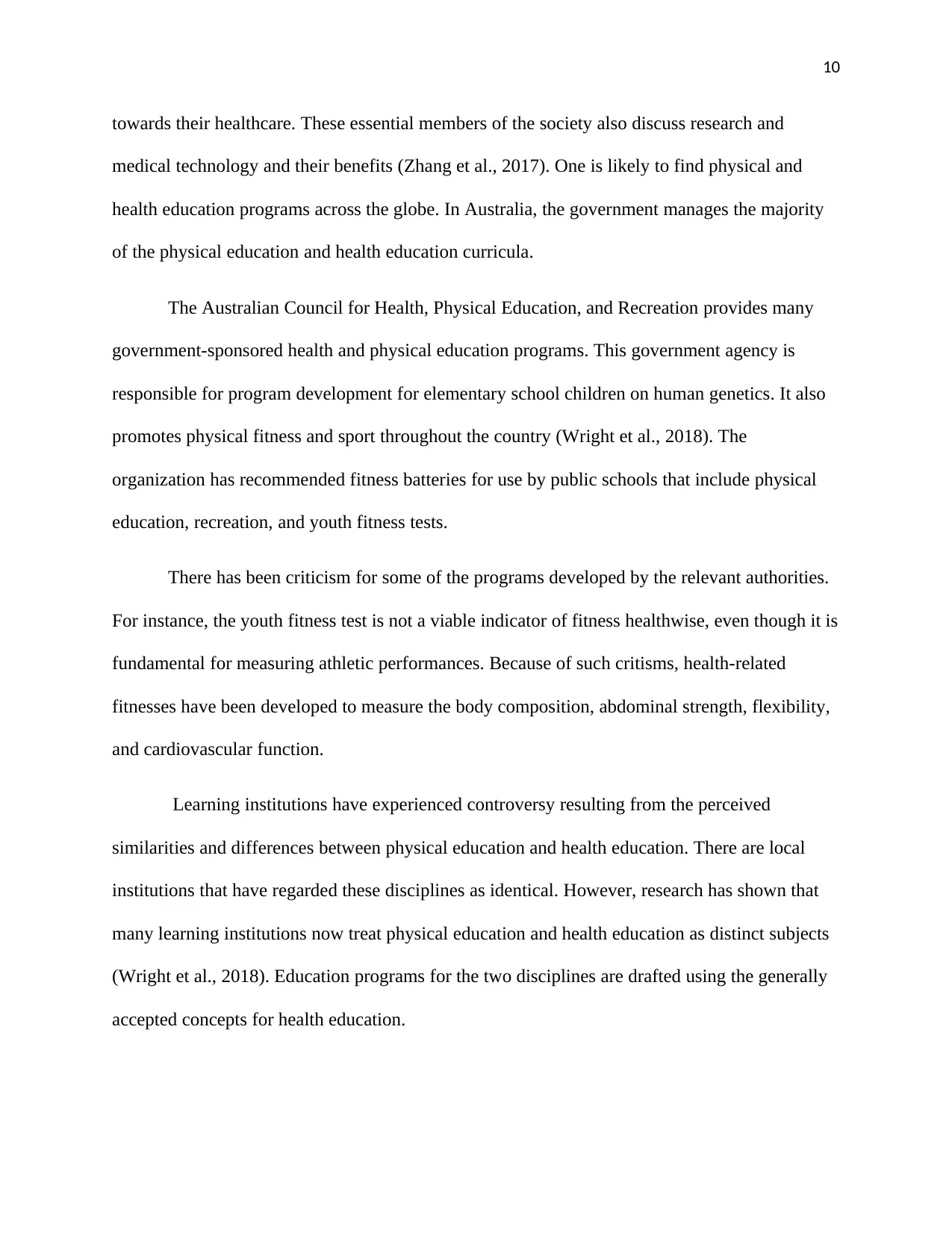
10
towards their healthcare. These essential members of the society also discuss research and
medical technology and their benefits (Zhang et al., 2017). One is likely to find physical and
health education programs across the globe. In Australia, the government manages the majority
of the physical education and health education curricula.
The Australian Council for Health, Physical Education, and Recreation provides many
government-sponsored health and physical education programs. This government agency is
responsible for program development for elementary school children on human genetics. It also
promotes physical fitness and sport throughout the country (Wright et al., 2018). The
organization has recommended fitness batteries for use by public schools that include physical
education, recreation, and youth fitness tests.
There has been criticism for some of the programs developed by the relevant authorities.
For instance, the youth fitness test is not a viable indicator of fitness healthwise, even though it is
fundamental for measuring athletic performances. Because of such critisms, health-related
fitnesses have been developed to measure the body composition, abdominal strength, flexibility,
and cardiovascular function.
Learning institutions have experienced controversy resulting from the perceived
similarities and differences between physical education and health education. There are local
institutions that have regarded these disciplines as identical. However, research has shown that
many learning institutions now treat physical education and health education as distinct subjects
(Wright et al., 2018). Education programs for the two disciplines are drafted using the generally
accepted concepts for health education.
towards their healthcare. These essential members of the society also discuss research and
medical technology and their benefits (Zhang et al., 2017). One is likely to find physical and
health education programs across the globe. In Australia, the government manages the majority
of the physical education and health education curricula.
The Australian Council for Health, Physical Education, and Recreation provides many
government-sponsored health and physical education programs. This government agency is
responsible for program development for elementary school children on human genetics. It also
promotes physical fitness and sport throughout the country (Wright et al., 2018). The
organization has recommended fitness batteries for use by public schools that include physical
education, recreation, and youth fitness tests.
There has been criticism for some of the programs developed by the relevant authorities.
For instance, the youth fitness test is not a viable indicator of fitness healthwise, even though it is
fundamental for measuring athletic performances. Because of such critisms, health-related
fitnesses have been developed to measure the body composition, abdominal strength, flexibility,
and cardiovascular function.
Learning institutions have experienced controversy resulting from the perceived
similarities and differences between physical education and health education. There are local
institutions that have regarded these disciplines as identical. However, research has shown that
many learning institutions now treat physical education and health education as distinct subjects
(Wright et al., 2018). Education programs for the two disciplines are drafted using the generally
accepted concepts for health education.
Secure Best Marks with AI Grader
Need help grading? Try our AI Grader for instant feedback on your assignments.
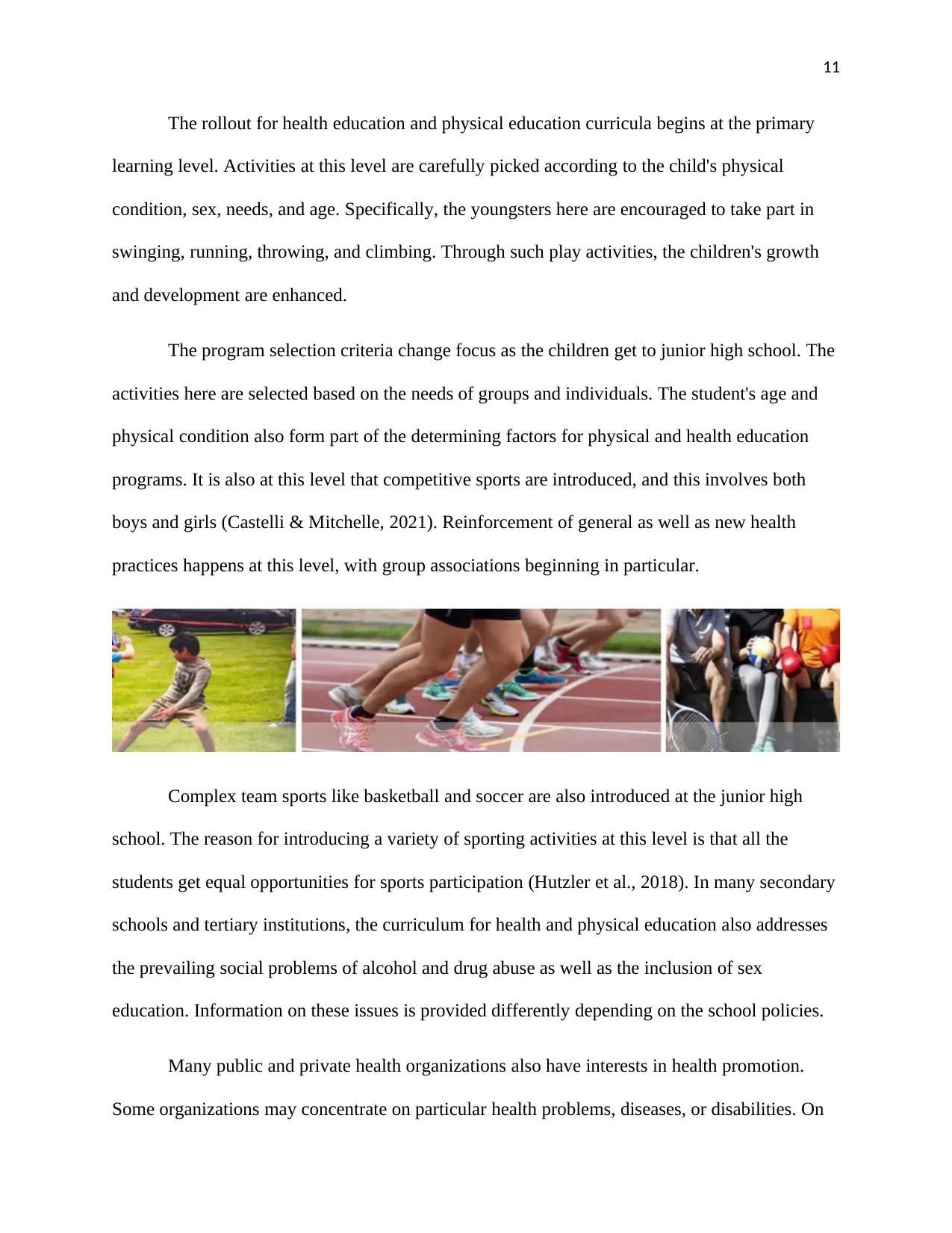
11
The rollout for health education and physical education curricula begins at the primary
learning level. Activities at this level are carefully picked according to the child's physical
condition, sex, needs, and age. Specifically, the youngsters here are encouraged to take part in
swinging, running, throwing, and climbing. Through such play activities, the children's growth
and development are enhanced.
The program selection criteria change focus as the children get to junior high school. The
activities here are selected based on the needs of groups and individuals. The student's age and
physical condition also form part of the determining factors for physical and health education
programs. It is also at this level that competitive sports are introduced, and this involves both
boys and girls (Castelli & Mitchelle, 2021). Reinforcement of general as well as new health
practices happens at this level, with group associations beginning in particular.
Complex team sports like basketball and soccer are also introduced at the junior high
school. The reason for introducing a variety of sporting activities at this level is that all the
students get equal opportunities for sports participation (Hutzler et al., 2018). In many secondary
schools and tertiary institutions, the curriculum for health and physical education also addresses
the prevailing social problems of alcohol and drug abuse as well as the inclusion of sex
education. Information on these issues is provided differently depending on the school policies.
Many public and private health organizations also have interests in health promotion.
Some organizations may concentrate on particular health problems, diseases, or disabilities. On
The rollout for health education and physical education curricula begins at the primary
learning level. Activities at this level are carefully picked according to the child's physical
condition, sex, needs, and age. Specifically, the youngsters here are encouraged to take part in
swinging, running, throwing, and climbing. Through such play activities, the children's growth
and development are enhanced.
The program selection criteria change focus as the children get to junior high school. The
activities here are selected based on the needs of groups and individuals. The student's age and
physical condition also form part of the determining factors for physical and health education
programs. It is also at this level that competitive sports are introduced, and this involves both
boys and girls (Castelli & Mitchelle, 2021). Reinforcement of general as well as new health
practices happens at this level, with group associations beginning in particular.
Complex team sports like basketball and soccer are also introduced at the junior high
school. The reason for introducing a variety of sporting activities at this level is that all the
students get equal opportunities for sports participation (Hutzler et al., 2018). In many secondary
schools and tertiary institutions, the curriculum for health and physical education also addresses
the prevailing social problems of alcohol and drug abuse as well as the inclusion of sex
education. Information on these issues is provided differently depending on the school policies.
Many public and private health organizations also have interests in health promotion.
Some organizations may concentrate on particular health problems, diseases, or disabilities. On
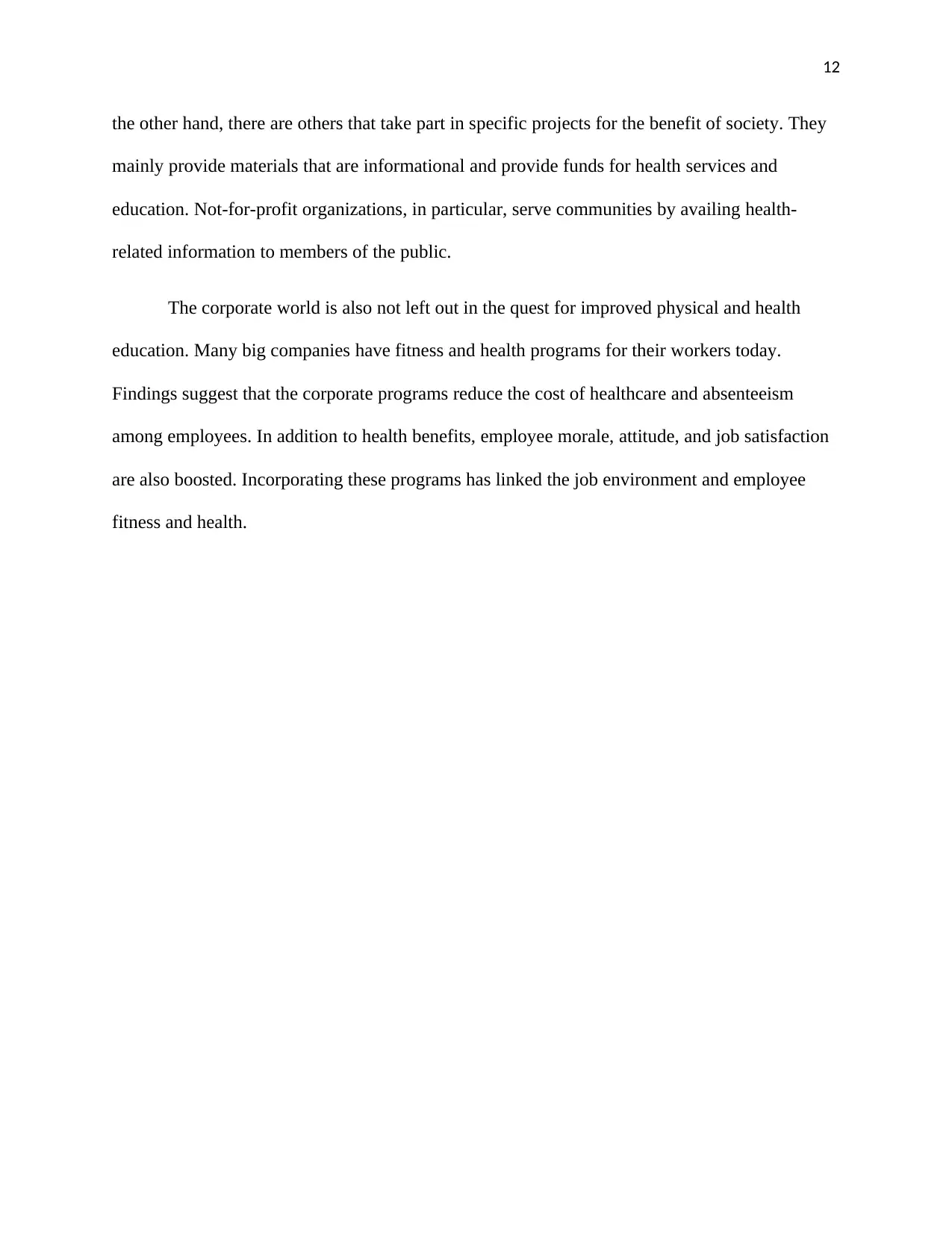
12
the other hand, there are others that take part in specific projects for the benefit of society. They
mainly provide materials that are informational and provide funds for health services and
education. Not-for-profit organizations, in particular, serve communities by availing health-
related information to members of the public.
The corporate world is also not left out in the quest for improved physical and health
education. Many big companies have fitness and health programs for their workers today.
Findings suggest that the corporate programs reduce the cost of healthcare and absenteeism
among employees. In addition to health benefits, employee morale, attitude, and job satisfaction
are also boosted. Incorporating these programs has linked the job environment and employee
fitness and health.
the other hand, there are others that take part in specific projects for the benefit of society. They
mainly provide materials that are informational and provide funds for health services and
education. Not-for-profit organizations, in particular, serve communities by availing health-
related information to members of the public.
The corporate world is also not left out in the quest for improved physical and health
education. Many big companies have fitness and health programs for their workers today.
Findings suggest that the corporate programs reduce the cost of healthcare and absenteeism
among employees. In addition to health benefits, employee morale, attitude, and job satisfaction
are also boosted. Incorporating these programs has linked the job environment and employee
fitness and health.
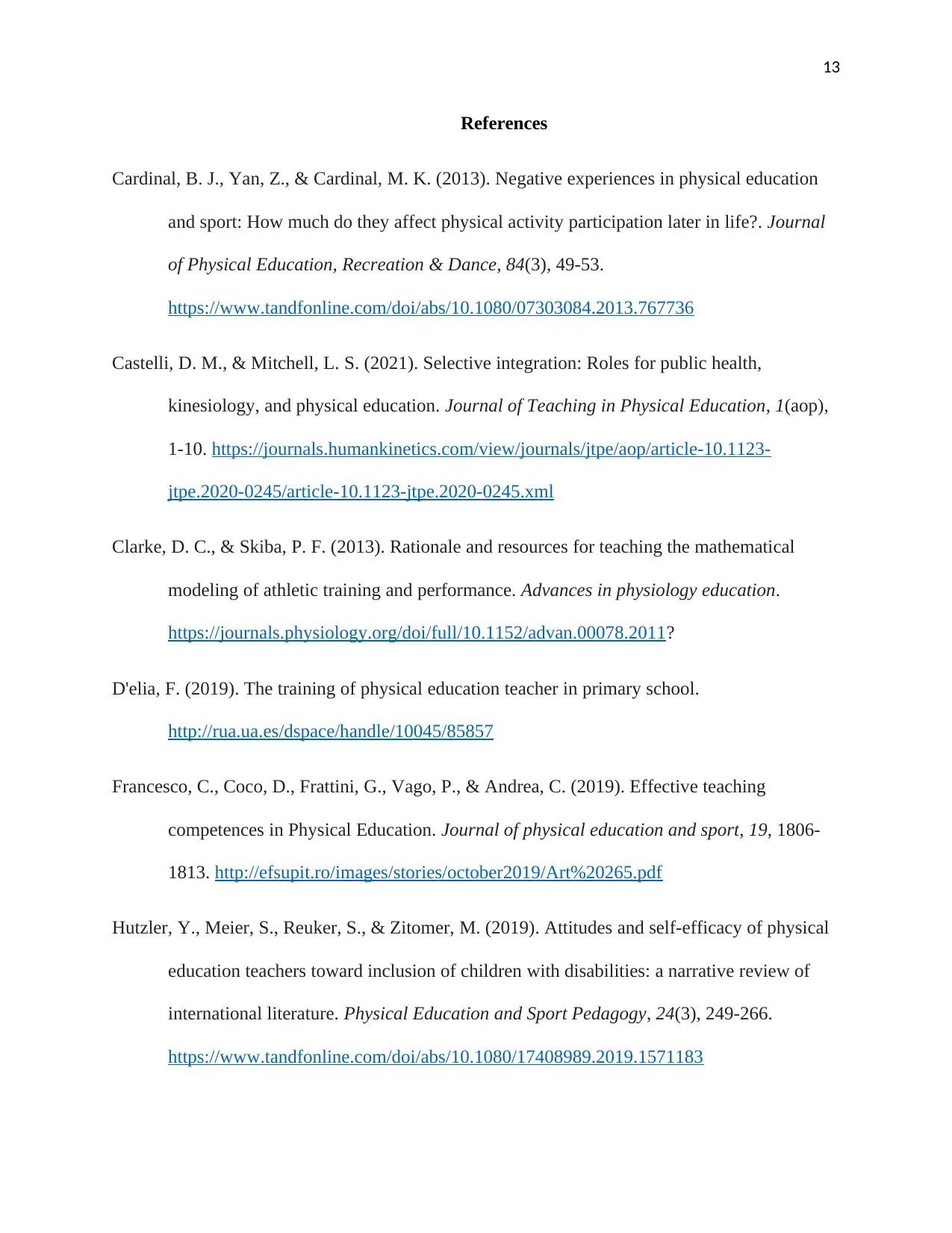
13
References
Cardinal, B. J., Yan, Z., & Cardinal, M. K. (2013). Negative experiences in physical education
and sport: How much do they affect physical activity participation later in life?. Journal
of Physical Education, Recreation & Dance, 84(3), 49-53.
https://www.tandfonline.com/doi/abs/10.1080/07303084.2013.767736
Castelli, D. M., & Mitchell, L. S. (2021). Selective integration: Roles for public health,
kinesiology, and physical education. Journal of Teaching in Physical Education, 1(aop),
1-10. https://journals.humankinetics.com/view/journals/jtpe/aop/article-10.1123-
jtpe.2020-0245/article-10.1123-jtpe.2020-0245.xml
Clarke, D. C., & Skiba, P. F. (2013). Rationale and resources for teaching the mathematical
modeling of athletic training and performance. Advances in physiology education.
https://journals.physiology.org/doi/full/10.1152/advan.00078.2011?
D'elia, F. (2019). The training of physical education teacher in primary school.
http://rua.ua.es/dspace/handle/10045/85857
Francesco, C., Coco, D., Frattini, G., Vago, P., & Andrea, C. (2019). Effective teaching
competences in Physical Education. Journal of physical education and sport, 19, 1806-
1813. http://efsupit.ro/images/stories/october2019/Art%20265.pdf
Hutzler, Y., Meier, S., Reuker, S., & Zitomer, M. (2019). Attitudes and self-efficacy of physical
education teachers toward inclusion of children with disabilities: a narrative review of
international literature. Physical Education and Sport Pedagogy, 24(3), 249-266.
https://www.tandfonline.com/doi/abs/10.1080/17408989.2019.1571183
References
Cardinal, B. J., Yan, Z., & Cardinal, M. K. (2013). Negative experiences in physical education
and sport: How much do they affect physical activity participation later in life?. Journal
of Physical Education, Recreation & Dance, 84(3), 49-53.
https://www.tandfonline.com/doi/abs/10.1080/07303084.2013.767736
Castelli, D. M., & Mitchell, L. S. (2021). Selective integration: Roles for public health,
kinesiology, and physical education. Journal of Teaching in Physical Education, 1(aop),
1-10. https://journals.humankinetics.com/view/journals/jtpe/aop/article-10.1123-
jtpe.2020-0245/article-10.1123-jtpe.2020-0245.xml
Clarke, D. C., & Skiba, P. F. (2013). Rationale and resources for teaching the mathematical
modeling of athletic training and performance. Advances in physiology education.
https://journals.physiology.org/doi/full/10.1152/advan.00078.2011?
D'elia, F. (2019). The training of physical education teacher in primary school.
http://rua.ua.es/dspace/handle/10045/85857
Francesco, C., Coco, D., Frattini, G., Vago, P., & Andrea, C. (2019). Effective teaching
competences in Physical Education. Journal of physical education and sport, 19, 1806-
1813. http://efsupit.ro/images/stories/october2019/Art%20265.pdf
Hutzler, Y., Meier, S., Reuker, S., & Zitomer, M. (2019). Attitudes and self-efficacy of physical
education teachers toward inclusion of children with disabilities: a narrative review of
international literature. Physical Education and Sport Pedagogy, 24(3), 249-266.
https://www.tandfonline.com/doi/abs/10.1080/17408989.2019.1571183
Paraphrase This Document
Need a fresh take? Get an instant paraphrase of this document with our AI Paraphraser
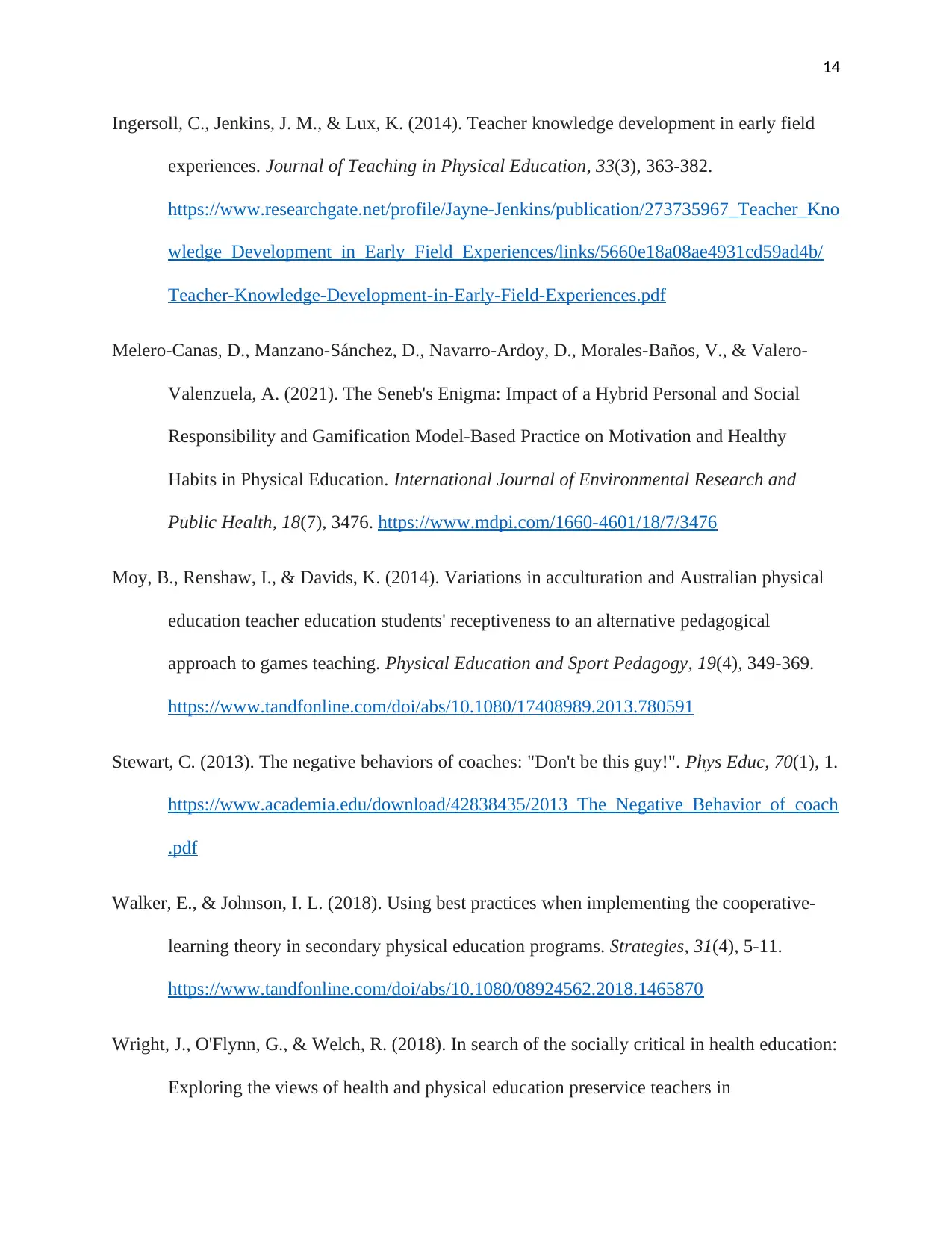
14
Ingersoll, C., Jenkins, J. M., & Lux, K. (2014). Teacher knowledge development in early field
experiences. Journal of Teaching in Physical Education, 33(3), 363-382.
https://www.researchgate.net/profile/Jayne-Jenkins/publication/273735967_Teacher_Kno
wledge_Development_in_Early_Field_Experiences/links/5660e18a08ae4931cd59ad4b/
Teacher-Knowledge-Development-in-Early-Field-Experiences.pdf
Melero-Canas, D., Manzano-Sánchez, D., Navarro-Ardoy, D., Morales-Baños, V., & Valero-
Valenzuela, A. (2021). The Seneb's Enigma: Impact of a Hybrid Personal and Social
Responsibility and Gamification Model-Based Practice on Motivation and Healthy
Habits in Physical Education. International Journal of Environmental Research and
Public Health, 18(7), 3476. https://www.mdpi.com/1660-4601/18/7/3476
Moy, B., Renshaw, I., & Davids, K. (2014). Variations in acculturation and Australian physical
education teacher education students' receptiveness to an alternative pedagogical
approach to games teaching. Physical Education and Sport Pedagogy, 19(4), 349-369.
https://www.tandfonline.com/doi/abs/10.1080/17408989.2013.780591
Stewart, C. (2013). The negative behaviors of coaches: "Don't be this guy!". Phys Educ, 70(1), 1.
https://www.academia.edu/download/42838435/2013_The_Negative_Behavior_of_coach
.pdf
Walker, E., & Johnson, I. L. (2018). Using best practices when implementing the cooperative-
learning theory in secondary physical education programs. Strategies, 31(4), 5-11.
https://www.tandfonline.com/doi/abs/10.1080/08924562.2018.1465870
Wright, J., O'Flynn, G., & Welch, R. (2018). In search of the socially critical in health education:
Exploring the views of health and physical education preservice teachers in
Ingersoll, C., Jenkins, J. M., & Lux, K. (2014). Teacher knowledge development in early field
experiences. Journal of Teaching in Physical Education, 33(3), 363-382.
https://www.researchgate.net/profile/Jayne-Jenkins/publication/273735967_Teacher_Kno
wledge_Development_in_Early_Field_Experiences/links/5660e18a08ae4931cd59ad4b/
Teacher-Knowledge-Development-in-Early-Field-Experiences.pdf
Melero-Canas, D., Manzano-Sánchez, D., Navarro-Ardoy, D., Morales-Baños, V., & Valero-
Valenzuela, A. (2021). The Seneb's Enigma: Impact of a Hybrid Personal and Social
Responsibility and Gamification Model-Based Practice on Motivation and Healthy
Habits in Physical Education. International Journal of Environmental Research and
Public Health, 18(7), 3476. https://www.mdpi.com/1660-4601/18/7/3476
Moy, B., Renshaw, I., & Davids, K. (2014). Variations in acculturation and Australian physical
education teacher education students' receptiveness to an alternative pedagogical
approach to games teaching. Physical Education and Sport Pedagogy, 19(4), 349-369.
https://www.tandfonline.com/doi/abs/10.1080/17408989.2013.780591
Stewart, C. (2013). The negative behaviors of coaches: "Don't be this guy!". Phys Educ, 70(1), 1.
https://www.academia.edu/download/42838435/2013_The_Negative_Behavior_of_coach
Walker, E., & Johnson, I. L. (2018). Using best practices when implementing the cooperative-
learning theory in secondary physical education programs. Strategies, 31(4), 5-11.
https://www.tandfonline.com/doi/abs/10.1080/08924562.2018.1465870
Wright, J., O'Flynn, G., & Welch, R. (2018). In search of the socially critical in health education:
Exploring the views of health and physical education preservice teachers in
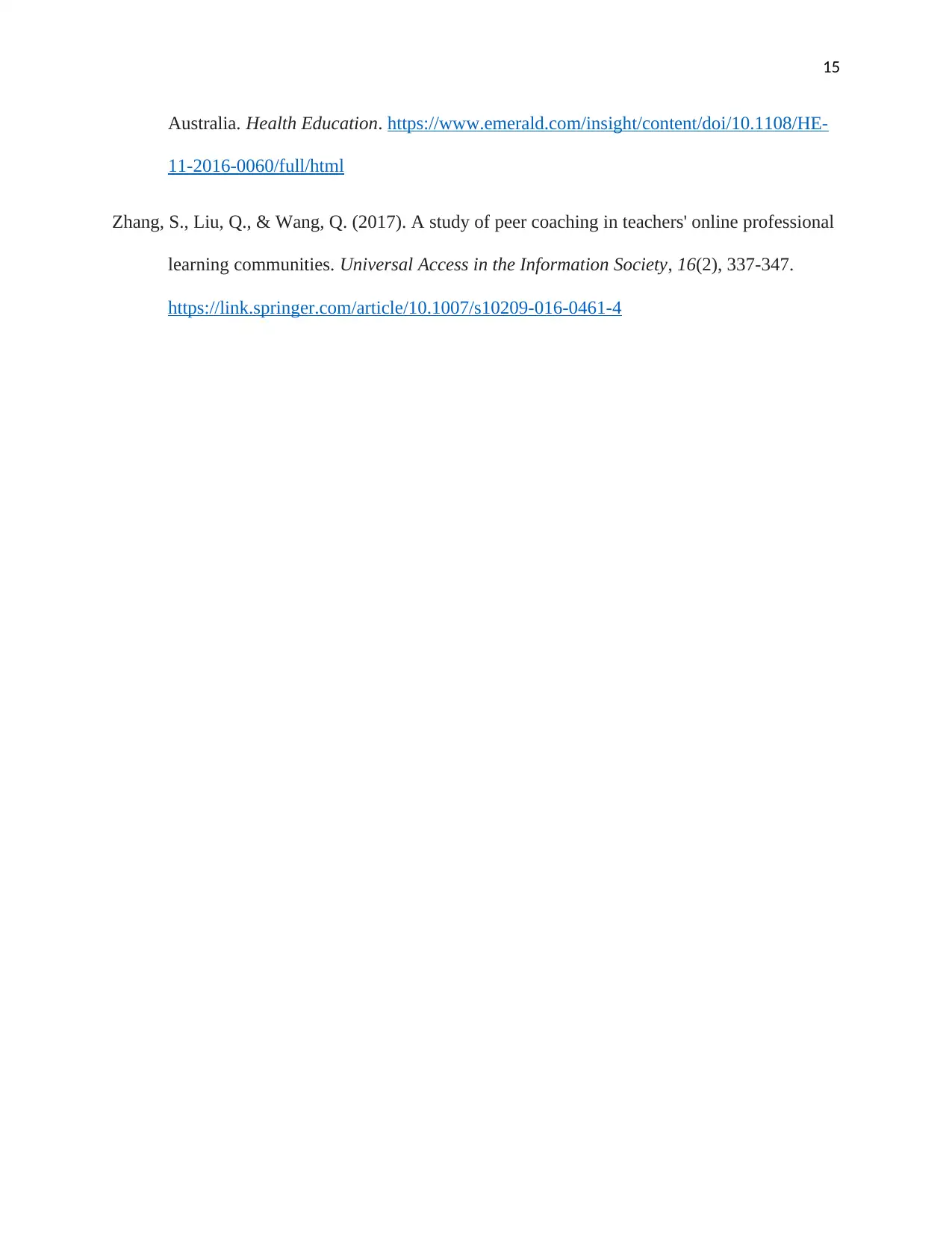
15
Australia. Health Education. https://www.emerald.com/insight/content/doi/10.1108/HE-
11-2016-0060/full/html
Zhang, S., Liu, Q., & Wang, Q. (2017). A study of peer coaching in teachers' online professional
learning communities. Universal Access in the Information Society, 16(2), 337-347.
https://link.springer.com/article/10.1007/s10209-016-0461-4
Australia. Health Education. https://www.emerald.com/insight/content/doi/10.1108/HE-
11-2016-0060/full/html
Zhang, S., Liu, Q., & Wang, Q. (2017). A study of peer coaching in teachers' online professional
learning communities. Universal Access in the Information Society, 16(2), 337-347.
https://link.springer.com/article/10.1007/s10209-016-0461-4
1 out of 15
Related Documents
Your All-in-One AI-Powered Toolkit for Academic Success.
+13062052269
info@desklib.com
Available 24*7 on WhatsApp / Email
![[object Object]](/_next/static/media/star-bottom.7253800d.svg)
Unlock your academic potential
© 2024 | Zucol Services PVT LTD | All rights reserved.





